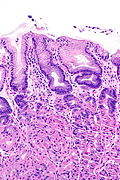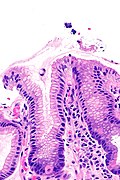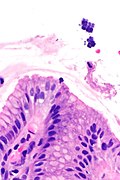Difference between revisions of "Sarcina"
Jump to navigation
Jump to search

(+images) |
|||
| Line 3: | Line 3: | ||
==General== | ==General== | ||
* | *Probably a commensal organism.<Ref name=pmid23599657/> | ||
*Uncommonly seen. | |||
*Associated with gastroparesis,<ref name=pmid23599657>{{Cite journal | last1 = Ratuapli | first1 = SK. | last2 = Lam-Himlin | first2 = DM. | last3 = Heigh | first3 = RI. | title = Sarcina ventriculi of the stomach: a case report. | journal = World J Gastroenterol | volume = 19 | issue = 14 | pages = 2282-5 | month = | year = 2013 | doi = 10.3748/wjg.v19.i14.2282 | PMID = 23599657 }}</ref> as may be seen in [[diabetes mellitus]]. | *Associated with gastroparesis,<ref name=pmid23599657>{{Cite journal | last1 = Ratuapli | first1 = SK. | last2 = Lam-Himlin | first2 = DM. | last3 = Heigh | first3 = RI. | title = Sarcina ventriculi of the stomach: a case report. | journal = World J Gastroenterol | volume = 19 | issue = 14 | pages = 2282-5 | month = | year = 2013 | doi = 10.3748/wjg.v19.i14.2282 | PMID = 23599657 }}</ref> as may be seen in [[diabetes mellitus]]. | ||
Revision as of 06:59, 10 June 2015

Micrograph showing Sarcina. H&E stain. (WC/Librepath)
Sarcina organisms are seen in gastrointestinal tract.
General
- Probably a commensal organism.[1]
- Uncommonly seen.
- Associated with gastroparesis,[1] as may be seen in diabetes mellitus.
Described complications:[1]
- Gastric perforation.
- Emphysematous gastritis.
Notes:
- Sarcina ventriculi = Gram-positive organism.[1]
Gross
Features:
- Erythema.
- +/-Gastric ulcer.
- +/-Retained food.
Microscopic
Features:[2]
- Four purple bodies (tetrad).
Images
Case 1
www
See also
References
- ↑ 1.0 1.1 1.2 1.3 1.4 Ratuapli, SK.; Lam-Himlin, DM.; Heigh, RI. (2013). "Sarcina ventriculi of the stomach: a case report.". World J Gastroenterol 19 (14): 2282-5. doi:10.3748/wjg.v19.i14.2282. PMID 23599657.
- ↑ Lam-Himlin, D.; Tsiatis, AC.; Montgomery, E.; Pai, RK.; Brown, JA.; Razavi, M.; Lamps, L.; Eshleman, JR. et al. (Nov 2011). "Sarcina organisms in the gastrointestinal tract: a clinicopathologic and molecular study.". Am J Surg Pathol 35 (11): 1700-5. doi:10.1097/PAS.0b013e31822911e6. PMID 21997690.






